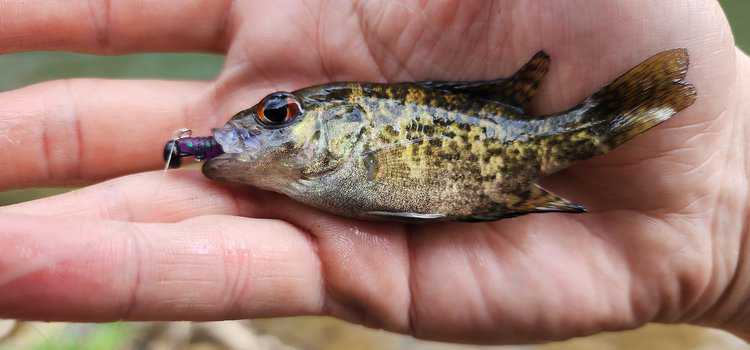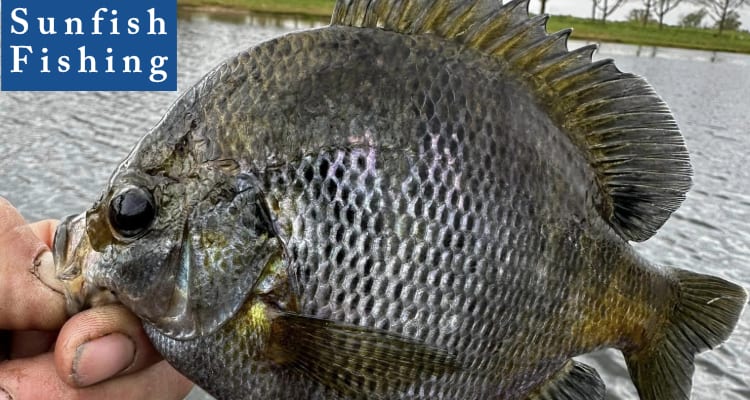Sunfish, a popular freshwater fish found across the United States, belongs to the Centrarchidae family, which also includes bass. This group of fish is quite diverse, with the common types being bluegill, pumpkinseed, redear, and the larger species like the largemouth bass often referred to colloquially as “sunfish” as well. These fish are known for their distinct, laterally compressed bodies, vibrant colors, and the spiny rays of their dorsal fins.
Catching sunfish is indeed easy and enjoyable, making them an excellent target for anglers of all skill levels, including beginners. This guide will cover the essentials for catching sunfish, including the fishing setup, best bait and lures, techniques, the best time to catch them, where to find them, tips for beginners, and the best fishing gear and tools.
Sunfish Fishing Setup
The most common tackle for catching sunfish includes lightweight and ultra-light spinning or spincast rods and reels, ideally suited for the small size and light bite of these fish. A rod between 4 to 6 feet in length paired with a reel spooled with 2 to 6-pound test line is optimal, providing the sensitivity needed to detect the light nibbles sunfish are known for.
The best setup for sunfish fishing is simple yet highly effective: a small hook, a light line, and a bobber. Specifically, using size 6 to 10 hooks accommodates the small mouth of the sunfish, ensuring a higher rate of successful hook-ups. A bobber or float attached to the line helps in monitoring the bites, as sunfish tend to nibble lightly. The bobber also keeps the bait at the desired depth, where sunfish are most likely to be feeding, usually in shallow waters near cover like weeds or docks.
Best Bait For Sunfish
Sunfish have a diverse diet that includes insects, zooplankton, small fish, and various aquatic invertebrates, making them receptive to a wide range of baits and lures.
The best live bait for sunfish includes worms (such as red wigglers or nightcrawlers), crickets, and grasshoppers. These baits are highly effective because they closely mimic the natural diet of sunfish. For using live bait, simply hook the bait through one end or the middle, ensuring it remains lively and attractive to fish. Place the bait under a bobber or let it sink slowly to the bottom near structures where sunfish congregate.
When it comes to artificial lures, small jigs, spinners, and fly-fishing flies are among the best choices for catching sunfish. Tiny jig heads (1/32 to 1/16 ounce) tipped with colorful soft plastic bodies can be very enticing, as their slow fall and lifelike movement mimic small prey. Spinners with small blades not only produce vibration but also flash in the water, attracting sunfish with their movement and mimicry of small fish. Flies, particularly those that imitate small insects or aquatic larvae, are highly effective when used in fly fishing or even beneath a bobber on a light spinning setup.

Sunfish Fishing Techniques
Bobber Fishing
Bobber fishing is among the most common and effective techniques for catching sunfish. This method involves using a light setup with a small hook (sizes 6 to 10), a split shot weight placed 6 to 12 inches above the hook, and a bobber attached to the line above the weight. The bobber serves as a strike indicator, visibly showing when a sunfish takes the bait. This technique is most effective in shallow waters near structures such as weeds, docks, or downed trees where sunfish are known to feed and take shelter. Adjust the depth of the bait by moving the bobber up or down the line, keeping it just above the bottom or in the middle of the water column where sunfish are actively feeding.
Sight Fishing
Sight fishing is a thrilling way to catch sunfish, especially in clear water conditions where you can visually locate the fish. This technique requires a stealthy approach to avoid spooking the fish. Use a lightweight rod and reel combo with a small hook and live bait such as worms or insects. Cast your bait near the observed sunfish, watching for the fish to take the bait. Sight fishing is most effective on sunny days when sunfish are easily spotted in the shallows, allowing anglers to target specific fish.
Fly Fishing
Fly fishing for sunfish is an enjoyable and effective technique, especially during the warmer months when sunfish are feeding on insects near the water’s surface. Use a lightweight fly rod, a floating line, and small flies that imitate the natural prey of sunfish, such as nymphs, wet flies, or small poppers. Casting near cover and retrieving the fly with gentle, intermittent pulls can entice sunfish to bite. This technique is particularly effective in the late afternoon or early morning when insects are most active and sunfish are hunting for food on the surface.
Best Time To Catch Sunfish
- Sunfish spawn in late spring to early summer when water temperatures reach about 67-70°F (19-21°C).
- Early morning and late afternoon are prime times to catch sunfish because they are more active in feeding during cooler, less bright parts of the day.
- Late spring through early fall is ideal for fishing sunfish, with peak activity around the spawn and when water temperatures are comfortable for the fish.
Spring
In spring, especially during and immediately after the spawning season, sunfish move into shallower waters to spawn, making them easier to target. Early morning and late afternoon are the best times to catch sunfish in spring, using live baits such as worms or small insects under a bobber near spawning beds.
Summer
During summer, the best time to catch sunfish is early morning and late afternoon to avoid the midday heat when sunfish are less active. Fly fishing with surface flies or poppers can be particularly effective in the early morning or late evening when sunfish are feeding on insects.
Fall
Fall brings cooler water temperatures, which can increase sunfish activity throughout the day, although early morning and late afternoon remain the best times to fish. Jigging small jigs tipped with live bait or using spinners around structure can be effective as sunfish prepare for winter by feeding more aggressively.
Winter
In regions where the water doesn’t freeze over, sunfish can still be caught, albeit with a bit more patience. During winter, target the warmest part of the day, usually midday when the sun has warmed the shallow waters. Slow-moving live bait under a bobber or small jigs can be effective, but presentations should be slower and near the bottom.
Night
Catching sunfish at night can be challenging, as they are less active and feed less. However, using lighted bobbers with live bait such as nightcrawlers or small minnows in areas with artificial light sources (like dock lights) that attract insects and small fish can increase your chances. The light attracts baitfish and insects, which in turn can attract sunfish.
Where To Catch Sunfish
Sunfish thrive across the United States, making them a favorite target for anglers in various locations. Some of the best locations for sunfish include the freshwater lakes, ponds, rivers, and streams found throughout the Midwest, South, and Northeast regions. Notable hotspots include the Mississippi River system, which traverses several states, offering abundant habitats for sunfish, and the lakes of Minnesota, known as the “Land of 10,000 Lakes,” where sunfish populations are particularly high.
Mississippi River System
The vast Mississippi River system, including its many tributaries and connected water bodies, is a prime location for sunfish. Here, the best technique is bobber fishing with live bait such as worms or small insects. Target areas with structure, such as logs, rocks, and vegetation, where sunfish seek shelter and feed. The natural flow of the river creates various habitats where sunfish congregate, making it an ideal place for anglers.
Minnesota Lakes
Minnesota, with its numerous lakes, is a haven for sunfish anglers. In these clear, freshwater environments, sight fishing becomes a highly effective technique, especially in the shallower areas during the spawning season. Using lightweight tackle with live bait or small jigs and casting near vegetation or other structures where sunfish spawn and feed can yield excellent results.
Southern Ponds and Lakes
In the South, ponds and lakes are abundant with sunfish, including bluegill and redear sunfish. Here, the best technique often involves using a small hook and live bait under a bobber near the edges of weed beds or under overhanging branches. The warm waters of the South encourage year-round activity, making these locations excellent for consistent sunfish action.
Northeast Rivers and Streams
The rivers and streams of the Northeast are excellent for fly fishing, particularly for those targeting sunfish. Using small flies that mimic local insects can be particularly effective in these moving waters. Look for sunfish in slower-moving sections of streams or rivers, where they often feed on surface insects or aquatic invertebrates.
Common Sunfish Types
Sunfish are a diverse group of freshwater fish belonging to the Centrarchidae family, widely distributed across North America. They are popular among anglers for their vibrant colors, aggressive behavior, and delicious taste. Here’s an overview of some of the most common types of sunfish:
Bluegill (Lepomis macrochirus)
Bluegill are among the most recognized sunfish, known for their deep blue and purple on the face and gill cover, dark olive-banded bodies with orange to yellow bellies, and a distinctive black spot on the dorsal fin. They inhabit lakes, rivers, and ponds, and are famous for their spirited fight when hooked. Fishing bluegill with live bait such as worms or small insects is very effective.
Pumpkinseed (Lepomis gibbosus)
Pumpkinseeds are colorful fish with a round, laterally compressed body, showcasing vibrant patterns of blue, orange, and yellow. They feature a red spot on the ear flap, making them easily distinguishable. Pumpkinseeds prefer clear waters with abundant vegetation and are found in ponds, lakes, and slow-flowing rivers.
Redear Sunfish (Lepomis microlophus)
Redear Sunfish are also known as shellcrackers due to their preference for snails and clams. They have a more elongated body compared to other sunfish. They are distinguished by a red or orange border on the opercular flap. Redears are commonly found in warmer southern waters, preferring habitats with sandy or muddy bottoms.
Warmouth (Lepomis gulosus)
Warmouths are sturdy, dark-colored fish with large mouths and a body mottled with brown, green, and black. They inhabit sluggish waters, such as swamps, lakes, and backwaters of streams, often hiding among debris. Warmouths are less common than other sunfish species but are prized by anglers for their aggressive nature and tendency to take a variety of baits and lures.
Largemouth Bass (Micropterus salmoides)
The Largemouth Bass is a freshwater game fish in the sunfish family, but it’s significantly different from the typical sunfish species like bluegill or pumpkinseed in size, behavior, and habitat preference. Largemouth Bass fishing techniques are different from other sunfish species due to their aggressive behavior and the challenge they present to anglers.

